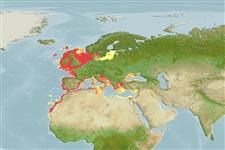>
Gobiiformes (Gobies) >
Gobiidae (Gobies) > Gobiinae
Etymology: Lesueurigobius: From Charles Alexandre Leueur, painter that travelled with the scientific expeditons of Nicolas Baudin (1880-1804) in the ships "Géographe" and "Naturaliste" (Ref. 45335).
Environment: milieu / climate zone / depth range / distribution range
Ecologia
marino demersale; distribuzione batimetrica 10 - 130 m (Ref. 5299). Subtropical; 62°N - 18°N, 18°W - 36°E
Eastern Atlantic: Spain to Skagerrak and Kattegat; Mauritania (Cape Corbiero to Nouakchott). Also in the Mediterranean (into Sea of Marmara);
Length at first maturity / Size / Peso / Age
Maturity: Lm 4.5, range 4 - 5 cm
Max length : 13.0 cm TL maschio/sesso non determinato; (Ref. 35388); Età massima riportata: 11 anni (Ref. 4696)
Yellowish-brown spots on body and dorsal fins. Distinct sense-papillae between the eyes (Ref. 35388). nape scaled and lateral line system with antero-dorsal longitudinal neuromast rows g long and h reduced to a few papillae (Ref. 86376)
Cryptobenthic, burrowing in muddy sand or mud; often associated with a decapod crustacean Nephrops norvegicus (Ref. 5299). Feed on polychaetes, small crustaceans and mollusks (Ref. 4696). Eggs are deposited in burrows (Ref. 35388).
Miller, P.J., 1990. Gobiidae. p. 925-951. In J.C. Quero, J.C. Hureau, C. Karrer, A. Post and L. Saldanha (eds.) Check-list of the fishes of the eastern tropical Atlantic (CLOFETA). JNICT, Lisbon, SEI, Paris; and UNESCO, Paris. Vol. 2. (Ref. 5299)
IUCN Red List Status (Ref. 130435)
Threat to humans
Harmless
Human uses
Informazioni ulteriori
BibliografiaAcquacolturaProfilo di acquacolturaVarietàGeneticaElectrophoresesEreditarietàMalattieElaborazioneNutrientsMass conversion
Strumenti
Special reports
Download XML
Fonti Internet
Estimates based on models
Preferred temperature (Ref.
123201): 7.2 - 18.4, mean 10.4 °C (based on 410 cells).
Phylogenetic diversity index (Ref.
82804): PD
50 = 0.5312 [Uniqueness, from 0.5 = low to 2.0 = high].
Bayesian length-weight: a=0.00603 (0.00373 - 0.00972), b=3.05 (2.91 - 3.19), in cm total length, based on LWR estimates for this species & (Sub)family-body (Ref.
93245).
Trophic level (Ref.
69278): 3.4 ±0.4 se; based on size and trophs of closest relatives
Generation time: 1.6 ( na - na) years. Estimated as median ln(3)/K based on 1
growth studies.
Resilienza (Ref.
120179): Medio, tempo minimo di raddoppiamento della popolazione 1.4 - 4.4 anni (tm=2; tmax=11).
Fishing Vulnerability (Ref.
59153): Low vulnerability (21 of 100).
Nutrients (Ref.
124155): Calcium = 186 [89, 398] mg/100g; Iron = 1.43 [0.77, 2.82] mg/100g; Protein = 18.3 [16.4, 20.0] %; Omega3 = 0.404 [0.188, 0.713] g/100g; Selenium = 23.7 [11.7, 47.1] μg/100g; VitaminA = 17.8 [5.3, 56.1] μg/100g; Zinc = 1.18 [0.80, 1.76] mg/100g (wet weight);
